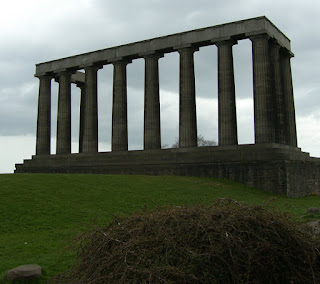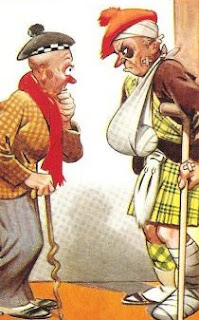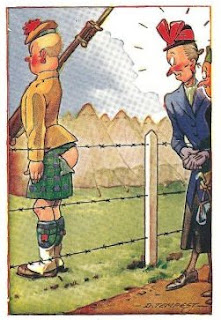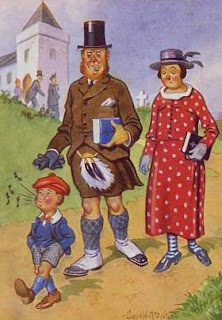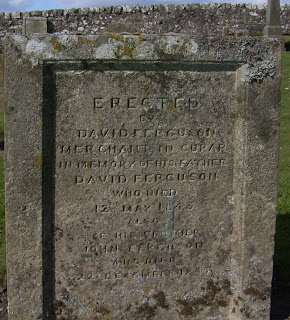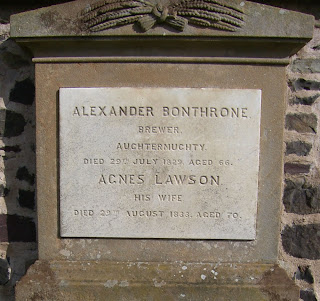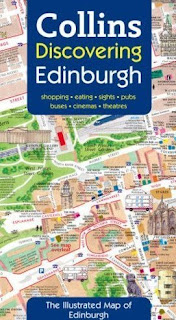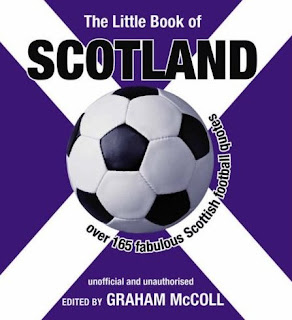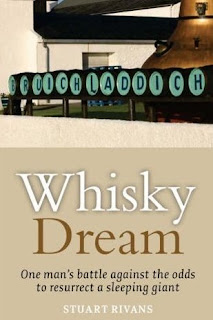Best Scottish Tours of
Rattray Parish Churchyard, Blairgowrie and Rattray, Perthshire, Scotland. Rattray in 1846, a parish, in the county Perth, one mile from Blairgowrie, containing, with the villages of Old and New Rattray, 1918 inhabitants, of whom 447 are in the former, and 580 in the latter, village. This place lays claim to a considerable degree of antiquity, and is supposed to have derived its name, of which the etymology is uncertain, from the family of Rattray, by whom, according to records yet extant, it appears to have been possessed prior to the year 1066, and whose descendants are still the principal proprietors. Of the castle of Rattray, the original seat of that family, there are some remains on the hill of Rattray, a spacious oblong eminence to the south-east of the village, rounded at the eastern extremity, and on the summit of which the ruins form a pleasingly romantic object, conveying an adequate idea of its original grandeur. During the frequent intestine wars which subsisted between the rival factions in the reigns of some of the Scottish kings, the family, not thinking themselves secure in the castle of Rattray from the incursions of their enemies, removed to the castle of Craighall, about two miles north-west of the village, and which since that period has continued to be their residence. The inhabitants were formerly noted for the celebration of various sports, of which the most general were curling, archery, and the game called the "long ball;" and there were, till the year 1745, preserved in the parish, a silver curling-stone, a silver arrow, and a silver ball, which were severally awarded as prizes to the successful competitors in these respective games. Any parish in Scotland might contest with the people of Rattray for the prize in these games, which always took place within the parish; and the successful candidate was bound to restore the prize he had obtained, previously to the next annual celebration. The curlingstone and the arrow were lost during the time of the rebellion; but the silver ball, which has been contested for within the present century, is still in the possession of Alexander Whitson, of Parkhill.
The parish comprises a part of the vale of Strathmore, and is bounded on the west and on the south by the river Ericht, which separates it from the parish of Blairgowrie. Including a widely detached portion of it, which lies on the confines of Forfarshire, it is about six miles and a half in extreme length and nearly two miles in mean breadth; comprising about 6500 acres, of which 4500 are arable, 450 woodland and plantations, and the remainder moor and waste. The surface towards the south, for some breadth along the banks of the river, is tolerably level; but towards the north it increases in elevation till it nearly reaches the village, beyond which it rises by steep acclivities into rugged and precipitous hills, forming part of the chain which, some miles beyond the limits of the parish, terminates in the Grampian range. The only river connected with the parish is the Ericht, which has its source in some springs issuing from the Grampian hills, and, flowing southward, receives the waters of the Ardle, a considerable mountain stream from the north-west. After this, passing the mansion of Craighall, and taking an eastern course, it bounds the parish on the south, and about two miles off falls into the Isla near Coupar-Angus, and flows in conjunction with that river into the Tay. The Ericht in the winter often overflows its banks, and after rains in the autumn, also, sometimes inundates the adjacent lands, occasioning much damage to the crops; it abounds with trout, affording good sport to the angler, and salmon are found in it during the season. In its course, which is rapid, it forms the beautiful cascade of Keith, where the water, obstructed by a rock, falls into a pool beneath, on which is a salmon-fishery belonging to Lord Wharncliffe. The general scenery, from the variety of the surface and the belts of wood and plantations scattered over it, is pleasingly diversified; and from the numerous hills are obtained some fine prospects over the fertile vale of Strathmore and the surrounding country.
The soil on the hills and uplands is thin, cold, and moorish, and in the lower parts dry and gravelly; but, though in some places encumbered with loose stones, it is generally fertile, producing favourable crops of oats, barley, and wheat, with potatoes and turnips, and the usual grasses. In the higher parts is a common of about 300 acres, called the Broad Moss, fit only for cutting turf for fuel. The system of husbandry is improved, but there is little in the parish to require agricultural notice; the majority of the farms are of very moderate extent, and those on the higher lands are employed mainly for the pasture of cattle and sheep. The cattle are of the Strathmore and Angus breeds, with a mixture of the Teeswater; they are mostly bought in at the neighbouring fairs, and when two or three years old are fed for the butcher, or sold to dealers who send them to the Glasgow market. The plantations consist chiefly of larch and Scotch fir; they are under careful management, and are regularly thinned, and the produce sold for fuel. Along the river are coppices of oak, which is cut down at a proper age, principally for the bark, which yields a profitable return. The rocks on the banks of the Ericht, near Craighall, rise perpendicularly to the height of 200 feet, and are of rugged and formidable appearance; they consist of enormous masses of whinstone, which have never been wrought for any purpose. The ascent to the summit, even where least precipitous, is difficult and dangerous; and a few trees only have been planted on the surface. Craighall, the seat of Robert Clerk Rattray, is a spacious castellated mansion, romantically situated on the summit of one of these rocks, 214 feet in height, overhanging the river, and commanding from the drawing-room windows an extensive view of the singularly impressive scenery of the adjacent country, marked with features of wild sublimity and romantic grandeur. This venerable mansion, of which the original date is not known, is accessible only from the south; it was internally remodelled by the late Baron Rattray, who added also, to the front, two turrets at the angles, corresponding in character to those which flank the entrance gateway in the centre. Parkhill is a handsome modern mansion, beautifully situated on the brow of a hill to the north of the village, and embracing a richly diversified prospect over the picturesque and fertile vale of Strathmore.
The village of Old Rattray, which is evidently a place of considerable antiquity, is irregularly built on the southern declivity of a hill, and has greatly increased within the present century, from the facilities of water-power afforded by the river, over which, some miles above the village, a bridge has been constructed by Colonel Sir W. Chalmers. This bridge, which affords communication between the portions of that gentleman's lands on both sides of the stream, consists of a horizontal platform of iron, supported by pillars of stone at each extremity, and is of sufficient breadth for a carriageroad, and a footpath on each side of it. New Rattray is neatly built, extending along the road to Blairgowrie, and is nearly contiguous to the village of Old Rattray; it was commenced in 1809, and from the pleasantness of the scenery, and the healthfulness of its situation, is a favourite resort for invalids from various parts, for whose accommodation there is an excellent inn. The linen manufacture is carried on to a very considerable extent. There are not less than eight mills for the spinning of flax, which are driven by water-wheels of from eight to twenty horse power, and afford employment to 650 persons, inhabitants of the villages. In one of these mills, called the Erichtside mill, are also sixty-seven power-looms constantly employed in the weaving of linen cloths of various qualities; and almost all of the inhabitants of the parish, when not engaged in agricultural pursuits, are occupied in hand-loom weaving at their own dwellings for the houses of Dundee. The handicraft trades requisite for the supply of the district are also carried on in the villages, in which there are a few shops. Fairs, chiefly for the sale of cattle, are held on the last Fridays in April and August, on a common to the west of the village, and are in general numerously attended. Letters are received daily from the post-office of Blairgowrie, in the immediate vicinity; and facility of communication is maintained by the military road to Fort-George, by Braemar, which passes through the parish, and by the turnpike-road to Alyth and Kirriemuir. The rateable annual value of Rattray is £5229. The ecclesiastical affairs are under the superintendence of the presbytery of Dunkeld and synod of Perth and Stirling. The minister's stipend is £157. 9. 2., of which nearly onehalf is paid from the exchequer; with a manse, and a glebe valued at £25 per annum: patron, the Earl of Kinnoull. The church, built in 1820, to replace the ancient church, which had fallen into decay, is a substantial and handsome structure with a square tower, and contains 620 sittings. There are also places of worship for members of the Free Church and United Secession. The parochial school, situated near the church, in the village of Old Rattray, is attended by about sixty children; the master receives a salary of £34. 4. 4. per annum, with a house, and the school fees average £15. On an eminence half a mile to the east of the village, and also on another about a mile to the north of it, are the remains of a Druidical circle. Near the former were lately discovered in a field of hard gravel, two deep trenches in the form of a crescent with the horns towards the east, having the sides formed with rough stones, and covered with large flags of whinstone, and containing earth of a dark colour intermixed with fragments of burnt bones. There was also till within the last few years, to the east of the village, a large cairn of earth and stones in alternate layers, the base of which covered about half an acre; every layer of earth contained a mixture of burnt bones and wood, and in the centre of the cairn was found a stone coffin holding half-calcined bones and a warlike weapon nearly resembling a dagger.


